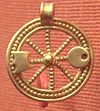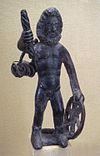- Mogons
-
Mogons or Moguns was a god worshipped in Roman Britain and in Gaul. The main evidence is from altars dedicated to the god by Roman soldiers, but the deity is not a native Italic one. It appears to be Celtic. Inscriptional spellings include Mogetios, Mogounos, Mogti, Mounti, Mogont, Mogunt. Not all of these words are necessarily in the nominative case. For example, Mounti is a dative, probably *Mogunti, from a hypothetical nominative, *Moguns, of a back-formed Latin stem, *Mogunt-.
Etymologically the name can be seen to be the same as the English word Might personified. It has been translated by others as greatness or the great one. The fact that ordinary soldiers adopted him tends to support a "powerful" or "effective" interpretation rather than self-glorification.
Contents
Centres of worship
Altar-stones raised to Mogons have been recovered in the United Kingdom, such as the stones found at the following locations. The number is the catalog number of the artifact and the name in parentheses is the word as it appears on the stone, not necessarily (and probably not) in the nominative case. Most are datives, to be translated as "to" the god:
- Voreda (Old Penrith): 921 (Mogti), 922 (Mounti)
- Castra Exploratorum (Netherby, Cumbria): 971 (Mogont Vitire)
- Habitancum (Risingham): 1225 (Mogonito, dative of *Mogonitus, adjective formed from *Mogons), 1226 (Mouno, *Moguno, dative of *Mogunus)
- Bremenium (High Rochester): 1269 (Mountibus, *Moguntibus, dative plural of *Moguns)
- Vindolanda (Chesterholm): 1722d (Mogunti et Genio Loci).
Modern Mainz takes its name from Castrum Moguntiacum, a Roman base placed there. It is hypothesized that Moguns gave his name to it. The inscription at Habitancum identifies the troops stationed at that location as being from the Vangiones, the Gaesati and Rhaetia; i.e., from Germania Superior. Mainz was in the territory of the Vangiones, who were Belgae.
The question of whether Moguns was Celtic or Germanic hinges to a large degree on the ethnicity of the Vangiones. As Belgae, they were considered Celts of Germanic origin. If they had still spoken Germanic, they would have been considered Germanic. Whether Celtic or Germanic, they were not the original population in the region, which had been purely Celtic, but must have been moved into it or allowed to settle there by the Romans. The Celts of Julius Caesar's time had evacuated the region through fear of the Suebi. The defense of the region against the latter is the main reason for the Roman base.
The Habitancum inscription contains also the expression Deo Mogonito Cad... with the letters following Cad missing. As the region is in the territory of the historic Scottish tribe called the Gadeni, centered around Jedburgh (Jed possibly from Cad), the Cad.. is interpreted as some case of Cadeni. One speculation is that the Cadeni were a section of the Vangiones. Some derive Cadeni from Gaedhal, or Gael. A third theory derives Cad from catu-, "battle", with a sense "to the battle god, Mogon...".
Considering that the gods worshipped in the future Alsace, then home of the Vangiones, were Celtic, such as Grannus, Moguns is currently taken to be Celtic.[citation needed] The -uns is a specifically Celtic suffix. As for the historic Gadeni, their origin is not known. They could be the remnants of the Vangiones or possibly among the indigenes. Perhaps the future discovery of additional inscriptions or the future publication of inscriptions already known but unpublished will shed further light on Mogons.
Associations
Based on the concentration of altars in Cumbria, which is in some places hilly terrain, some have characterized Moguns as a mountain god, and the derivation of the name might support the meaning of "high." However, Cumbria and Yorkshire are not the location of the real mountains in Britain and they are not the historical highlands. Alsace contains highlands but it would be hard to find land in that general area that did not. None of the hills and highlands contain the high mountains that are usually associated with mountain gods, such as the Alps, Pyrenees, or Caucasus.
Some connect ancient Magonsaete (modern Kenchester, England) with Magons, but that name more likely comes from the ancient city of Magnis in the locality. There is no known connection between Magons and Magnis, and the latter name, although possibly from the same root (which is not a rarely used one) can be explained in other ways.
Magons may have had other epithets, such as Grannus or Veteros, as did most gods worshipped by the Romans. None yet are specifically mountain-related.
Etymology
According to Koch at the University of Wales[1], the various alternations of the name Moguns derive from the Romano-Celtic dialectal reflexes of Proto-Celtic *mogont-s, an Indo-European *-nt- -stem cognate with Sanskrit mahānt and Avestan mazant ‘great’ [2].
The word Magonus, an epithet of St. Patrick, the saint who converted Ireland to Christianity may be related: Koch [3] states that the ‘alternative name of Patrick Magonus ...Mauonius, Maun, &c., as found in Muirchiu’s Life and other Hagiography, might be related, though a derivative of Celtic *mogu-, *magu-, ’slave, servant,’ is also possible’ [4]. St. Patrick was not Irish. He was taken as a slave from Britain, escaped, converted to Christianity, and, following the dictates of a dream, returned to convert his former captors. He was not entirely British either, but belonged to a family descending from a Roman officer left behind when the Roman army evacuated Britain. The epithet is Magonus.
The CISP (Celtic Inscribed Stones) database published by the University College, London, records a number of names from Gaul related to some historical Welsh words. Welsh is a reflex (descendent) of the language spoken by the population among whom the Roman soldiers dedicating the altars were placed. Old Welsh maon or maun, a plural, comes from *magones (according to Julius Pokorny Page 695). Quite a few Gallic names featuring the word have been attested: Magunia, Magunius, Maguno, Magunna, Magonus, Magunus, including a king's name, Magono-rix. As they have a plural sense, they are probably Latin corruptions of Celtic *Magones.
Maon has a double meaning. On the one hand it means the king's subjects; on the other, a warband. Similarly Old Irish mug means slave. The plural, mogi, possesses the o otherwise seen mainly in Mogons. McBain's dictionary (under magh-) unites the two concepts as being based on the might of youth being used for service, whether noble or ignoble.
McBain's Indo-European root therefore is *magh-, seen also in English might and machine. McBain also connects it with Irish magh, "field", Gallic *magos, which McBain's explains means an "expanse" of earth.
The Indo-European linguist, Julius Pokorny, however, attributes might (Page 695)and magh (Page 709) to different roots. The "field" aspect is related to Indo-European *meg(h)- (palatal g), "big", giving rise to the translation "the great one" and the conclusion that Mogons might be a mountain god.
Under *meg(h)- Pokorny includes Gallic names such as Maginus, Magiorix, Aremagios and Old Welsh maon. Various persons have reconstructed slightly different proto-Celtic roots. Matasovic has *maglo-, *magos- and *magyo-, all from "great." A list of Proto-Celtic roots published by the University of Wales has *Mogon for "great".
Whichever possibility the reader selects, it seems clear that Mogons was a Gallic god rather than a Germanic one; moreover, he was a general Gallic god. The frequency of his altars among the Vangiones is only accidental. Publication of additional archaeological finds could change the picture at any time. There is no evidence of a mountain God. And finally, despite Pokorny (who does not always win agreement), the concept of young fighting men appealing to the strength of youth is much more apt than that of soldiers throwing themselves on the mercy of the great. Whenever Roman soldiers did so, discipline broke down totally and they became helpless.
Locations of artifacts
- ^ Koch, J.T. (2005:1300) Celtic Culture: A Historical Encyclopedia ABC-CLIO Ltd (15 Mar 2006); 978-1851094400
- ^ Koch, J.T. (2005:1300) Celtic Culture: A Historical Encyclopedia ABC-CLIO Ltd (15 Mar 2006); 978-1851094400
- ^ Koch, J.T. (2005:1300) Celtic Culture: A Historical Encyclopedia ABC-CLIO Ltd (15 Mar 2006); 978-1851094400
- ^ Koch, J.T. (2005:1300) Celtic Culture: A Historical Encyclopedia ABC-CLIO Ltd (15 Mar 2006); 978-1851094400
External links
Celtic mythology series Supra-regional Alaunus • Alisanos • Andarta • Anextiomarus • Artio • Aveta • Belenus • Belisama • Borvo • Brigantia • Camulus • Cernunnos • Cicolluis • Cissonius • Condatis • Damona • Matrona • Dis Pater • Epona • Erecura • Esus • Genii Cucullati • Grannus • Ialonus Contrebis • Lenus • Litavis • Loucetios • Lugus • Maponos • Matres • Mogons • Nantosuelta • Ogmios • Rosmerta • Segomo • Sirona • Sucellus • Suleviae • Taranis • Toutatis • Virotutis • VisuciusBritannia Gallia Aquitania Gallia Belgica Abnoba • Ancamna • Arduinna • Arvernus • Icovellauna • Inciona • Intarabus • Iovantucarus • Ritona • Veraudunus • Vindonnus • Vosegus • XulsigiaeGallia Celtica Gallia Cisalpina Gallia Narbonensis Germania Inferior Gallaecia Categories:- Ancient Gaulish and British gods
- War gods
Wikimedia Foundation. 2010.


